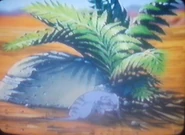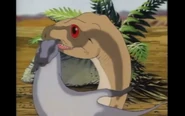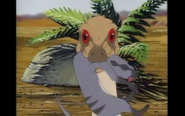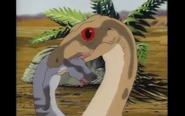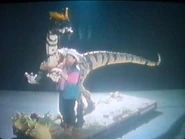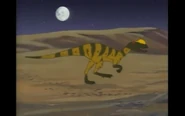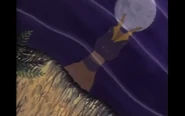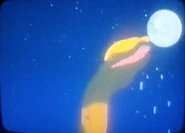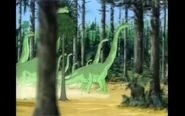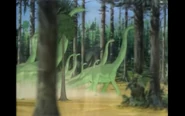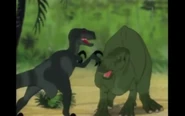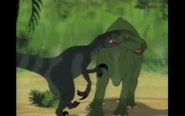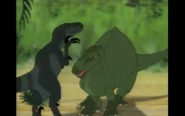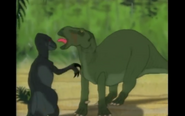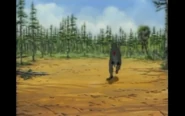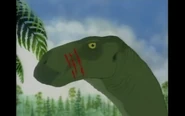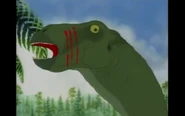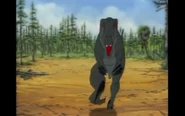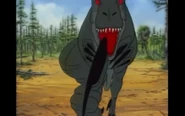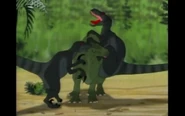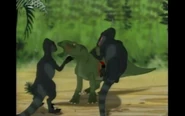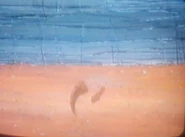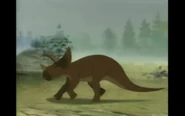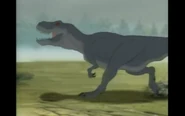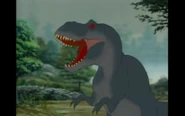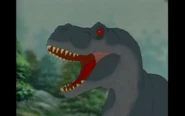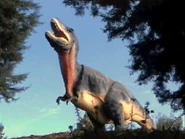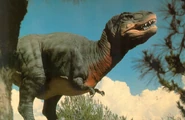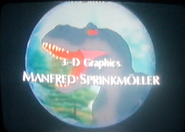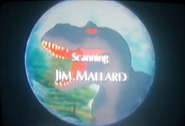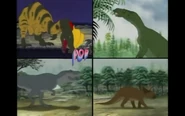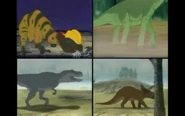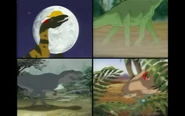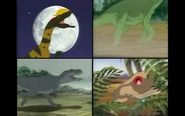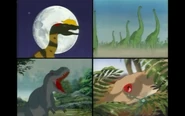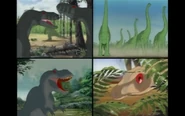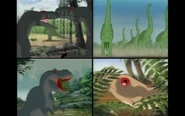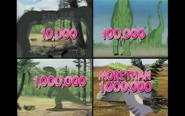Dinosaurs on Earth: Then...and Now was created in 1995 by the National Geographic Society, narrated by Pamela Conley.

The Plot[]
Animation shows the changes in the earth and the evolution of life from 4.5 billion years ago to the Triassic Period 228 million years ago. The continents were one big land mass called Pangaea. This was the beginning of the age of dinosaurs. The Jurassic Period started about 200 million years ago. More dinosaur species existed, including the Dilophosaurus. During the late Jurassic Period, 150 million years ago, Pangaea was breaking apart and dinosaurs were dispersed all over the world. Some of the largest animals in history lived at this time, including Brachiosaurus. During the Cretaceous Period, about 65 million years ago, the continents resembled their current arrangement. Utahraptor, Triceratops, and Tyrannosaurus rex lived during this last age of dinosaurs. All the dinosaurs disappeared, and by 50 million years ago, mammals became the dominant life form. Sediment in a pond may have buried a Utahraptor claw. It hardened into a fossil over millions of years and was covered by several kilometers of ground. Over time, erosion and earth movements will expose the fossilized claw.
In 1991, paleontologists discovered the fossilized Utahraptor claw in Utah. Paleontologist Jim Kirkland explains how this vicious 1,000-pound dinosaur used its sharp claws to attack its prey. It was very intelligent with highly developed senses and sophisticated coordination. Paleontologists study live animals to learn about dinosaurs. Paleontologist Robert Bakker studies birds because he believes they are related to dinosaurs. He compares the dangerous cassowary, a ground bird from Australia and New Guinea, to the Utahraptor. Both animals have claws on their hind legs. In the lab, Jim Kirkland shows a skull of a newly discovered dinosaur. Paleontologists compare the bones of modern animals with dinosaur fossils to learn about dinosaur anatomy and how their body parts functioned. Bakker compares an African elephant’s slow-moving legs to a Brachiosaurus. They form herds around their young to protect them from predators. In eastern Utah, herds of sauropods left such tracks.
Paleontologist Dave Weishample built a model of a hollow crest of a Parasaurolophus. Blowing through the model produces a sound similar to the sounds that dinosaur probably made. They used those sounds for warnings, mating calls, and communication with their young.
Tyrannosaurus rex was the last of the big predators. It had very wide, strong jaws, armor- piercing teeth, and could eat a ton of meat in one swallow.
Bakker compares an African hornbill bird to the Dilophosaurus and speculates that they had colorful crests for advertising themselves. Nearly all the meat- eating dinosaurs had a birdlike foot, with three toes going forward and one toe going back, which helps paleontologists identify dinosaur tracks. Bakker compares a Tyrannosaurus rex to an Indian rhino to prove that a multi ton animal can run 35 miles per hour.
Dinosaurs dominated the earth because they had the advantage of walking erect with their legs under their bodies. Kirkland discusses several theories about why the dinosaurs became extinct 65 million years ago, including an asteroid, diseases, temperature changes, and volcanoes. People continue to make new discoveries and learn more about dinosaurs.
Dinosaurs and Other Prehistoric Animals[]
- Early microscope creatures
- Early Fish
- Early Amphibians
- Early Reptiles
- Primitive Mammal
- Eoraptor
- Dilophosaurus
- Brachiosaurus
- Iguanodon
- Utahraptor
- Parasaurolophus
- Triceratops
- Tyrannosaurus rex
- Moeritherium
Gallery[]
Trivia[]
- The clip segments of Dinosaurs on Earth: Then...and Now were used as Stock Footage in National Geographic’s Really Wild Animals: Dinosaurs & Other Creature Features.
